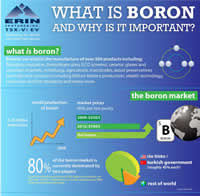
By clicking on this link you will be leaving the Erin Ventures website and entering the website of a third party. Erin Ventures has no control over this third party website and accepts no responsibility for either its content or its security. Erin Ventures does not adopt, confirm or endorse any information that may be contained on this website.
External links either open a new browser window or prompt you to view or save a PDF file on your computer. Click [X] to close these new windows to return to this page on the EV site.
(or press ESC or click outside this window)
This release contains forward looking statements. The words "believe," "expect," "feel," "plan," "anticipate," "project," "could," "should" and other similar expressions generally identify forward-looking statements. Readers are cautioned not to place undue reliance on these forward-looking statements. These forward-looking statements are subject to a number of risks and uncertainties including, without limitation, variations in estimated costs, the failure to discover or recover economic grades of minerals, and the inability to raise the funds necessary, changes in external market factors including commodity prices, and other risks and uncertainties. Actual results could differ materially from the results referred to in the forward-looking statements.
(or press ESC or click outside this window)
About Deep River, NC
EXPLORATION HISTORYAlthough the Deep River prospect has no recorded gold production, a few shallow prospect pits scattered throughout the area show evidence of historic gold exploration activity. The area lies within 10 kilometers of the historic Robbins gold mining district. The first modern exploration in the area was conducted by Noranda Exploration from 1989 to 1991 and consisted of extensive shallow soil sampling, trenching, an airborne geophysical survey and the drilling of 20 shallow saprolite holes up to 45 m deep (545 meters in total) and 9 core holes up to 205 m deep (838 m in total). All of the holes were drilled in a limited area and tested only a small portion of the large (3 km by 1 km) gold anomaly. Results included long intervals of anomalous gold mineralization up to 0.5 g/t. Cyprus Minerals carried out a limited mapping, sampling and trenching program before terminating their work in mid-1994 without conducting any additional drilling. To date approx. US $700,000 has been spent in 1995 dollars exploring the property with only a small portion of the known area of alteration/mineralization having been drill tested.
GEOLOGY AND MINERALIZATION
The Carolina Slate Belt is a late Proterozoic to early Paleozoic province associated with the Appalachian orogeny which consists of a complex stratigraphy of metamorphosed volcanic, sedimentary and intrusive rocks. The Carolina Slate Belt hosts the two-million ounce Ridgeway gold deposit mined by Kennecott from 1988 to 1999, together with the Haile, Brewer and Barite Hill gold mines in South Carolina. Gold production in the Carolina slate belt ranked sixth in the United States in 1992. The geologic setting is similar to world-class districts for both gold and base metals. This region is thought to have major potential for containing large undiscovered deposits of gold and silver, as well as copper, lead, zinc, and molybdenum.
Rocks within the prospect area consist principally of meta-sediments and intermediate to acidic volcanic rocks and associated intrusive rocks. The prospect area is adjacent to a broad northeast trending contact between meta-sediments and volcanic rocks. Proximity to this contact is a common factor among the major gold deposits within the Belt.
Within the altered porphyry intrusions, gold mineralization is primarily associated with silica flooding and stockwork quartz veining in highly fractured and brecciated quartz-sericite pyrite (phyllic) zones. Gold mineralization in the meta-sediments is hosted primarily by zones of silicification and moderate sericitization and is limited to the margins of the porphyry intrusions. Alteration patterns generally parallel known intrusions, indicating that most of the intrusions are pre-mineralization. The overall alteration pattern may outline the sub-surface distribution of a larger intrusive which acted as a possible source of this large mineralizing system.
» back to North Carolina
North Carolina
Click on a link below to learn more about North Carolina.» Property Photos
» Recent News
» About Deep River, NC




